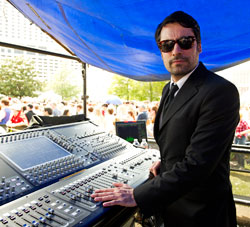
He keeps the setup simple and uncomplicated, relying on some of the console’s key features from presets to built-in plug-ins.
“I haven’t been much into using snapshots with this band. With the way these guys operate onstage and how their flow and feel of each song can differ from show to show, I prefer to follow along as we go rather than get the rug pulled out from under me when the guys decide to change things up on the fly.
“Having said that, I still absolutely rely on saving and recalling presets for all of the built-in comps and gates as well as the Waves plug-ins that I use, as well as having the ability to build macros to control things like delays and reverbs. I also love experimenting with things like bus compression and setting up different control groups for different instruments and vocals. Essentially, I am a huge fan of flexibility and being able to adjust quickly on the fly and having the ability to save and recall it all any time that I need to.
“Generally, I use the DiGiCo built-in comps on most of the channels, as well as the built-in gates for drums. I like the Waves SSL comps on snare drum and the SSL Strip inserted on any buss I may use. I also use a touch of the DiGiCo DDL on vocals from time to time. I keep a very simple approach and try not to get buried in plug-ins and FX, and use them as sparingly as possible to keep the signal path as clear as possible.”
Monitor engineer Fabian Quiroga adopts the same approach in his third tour with the band. With extensive, previous experience working with DiGiCo desks from D5s to SD7s on tours ranging from the Ringling Bros.
Circus to Columbian pop star Juanes, he’s found the SD8 familiar and easy to get around on.
“I keep it very minimal for these guys because they’re very minimal when it comes to their sound; they want to keep it as raw as possible,” he says. “I’ve been able to get most of what I need onboard. I’ve found the multiband compression is helpful and it’s my first time really experimenting with it. Macros are great for all kinds of effects and fading and it’s one of the greatest features of the board. I have 11 inputs coming from Pat, which is average for drums, but from Dan I have 10 inputs from his guitars alone.
“Some of the guitars I only use on certain songs and it’s good to be able to select what channel you want to mute. Same with Gus and John. They start the show with all four of them, but halfway through, Dan and Pat do about 5 songs solo and it’s just a matter of hitting one macro key and I can mute them or unmute with a press of a button.”
To date, only half of the four-piece is on in-ear monitors, with Auerbach and Carney still preferring the floor wedges and side fills.
“I just put Gus and John on ears this run,” Quiroga explains. “They both provide a lot of backup vocals and a lot of falsetto, and with the wedges being so close to their microphones, there was only so much that I could push them. I suggested they go on ears and it’s been a good transition. Pat and Dan are still on wedges and I’d never push ears onto them. They like to work off each other live, and because their music is so free and open, a lot of elements would change if I forced ears on them. But it’s really loud onstage; Dan’s got four guitar cabinets and they’re all pointing directly at me on stage left.
So I decided to go onto ears as well because I can’t expose myself to all that loudness all the time. I’m mixing about 50 percent of the show using them. We’ve got these new Ultimate Ears UE 18 Pros and they sound amazing.”
One of the most basic yet effective features for Quiroga is the talkback feature. “It’s the simple things that really matter and make your day-to-day routine easier, and this is very convenient.”
Having the ability and convenience to manage the consistency of the audio production in this new flush of the band’s success has been a boon for both engineers—and has had a noticeable effect on fans to band alike. And with international dates scheduled through the fall, it should be a smooth ride from here on out.
“Ultimately, I chose the console because of its flexibility and because of its fidelity,” sums Tarulli. “Initially, the challenge for me was to get consistency. In the past, not having the luxury of carrying any audio production, the best I could do was advance a list of things I would like to have and hope for the best. The ideal situation never really seemed to be the norm… ever.
“After a few years of essentially being thrown in front of just about every possible scenario (good and bad), the DiGiCo definitely stood out as one of the best overall-sounding desks. Once we began carrying gear with us, including the DiGiCo SD10s, everything became much more consistent night after night. We’ve also gotten more compliments about the way the shows are sounding, too… more than we have before. I would like to believe that the DiGiCo has been a part of that. I love it, and I know the band loves it too.”
